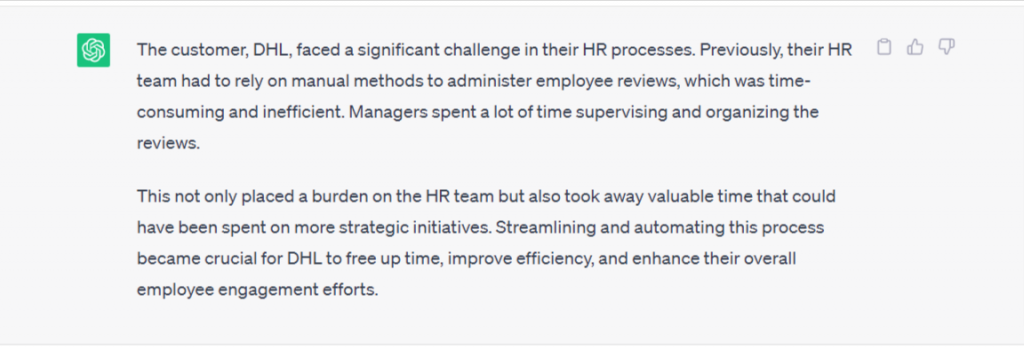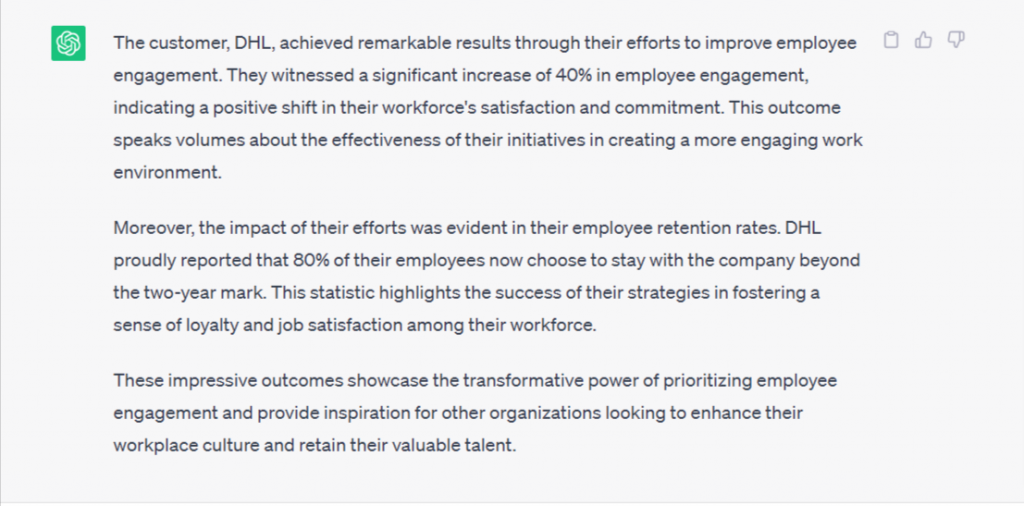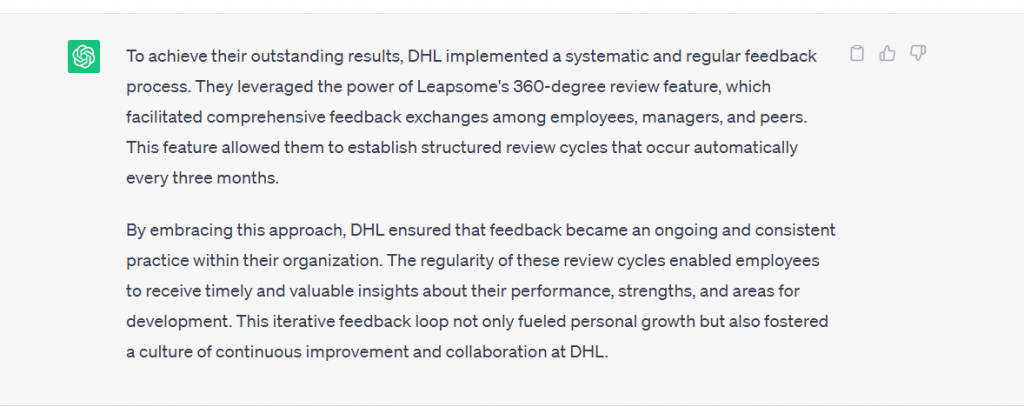Case studies and testimonials bear significant results. There’s no better way to convince prospects than showing them how someone like them achieved the result they seek with your product.
But like anything that bears significant results, creating case studies is grunt work. From the time it takes to collate the information to the interviews and the effort required to write convincingly.
But thanks to ChatGPT, it doesn’t have to be. It helps you automate some manual processes and create the first draft, which you can refine later.
Today, I’ll use ChatGPT to write a case study and product testimonials. I will share the prompts for gathering the necessary information and writing the copy.
But before that, remember….
Every piece of copy is assembled. Case studies and testimonials are no different. Information from customers is simply arranged in a logical fashion.
So, we start by using ChatGPT to create the email to contact the customer and generate the questions we’ll use for the interview.
Gathering the Information For Writing the Case Study
Below, I’ll instruct ChatGPT to write the email to solicit the customer’s participation before it generates the interview questions.
Crafting Email To Contact Suitable Customers
The best place to get authentic data for case studies and testimonials is from your customers.
You can decide the criteria for selecting a customer.
But it’s good practice to pick a customer you recently worked with. That way, they’ll remember their situation before and after using your product, which makes for a convincing case study or testimonial.
Also, the customer you include in the case study should be similar to the potential customer you wish to attract.
For example, if Leapsome wants to attract logistical companies, Uber — a technological company — won’t be a good candidate for the case study. But DHL — a logistical company — will suffice.
To save the time of your customers, it’s best you:
- Keep the email short. 100 words maximum.
- Use short sentences. At most, 10 words per sentence
- Write conversationally. Play on your prior relationship with the client
- Use an incentive to encourage action
- Personalize the email
- Answer their objections by informing them of the time limit and the benefits they’d get by participating in the case study. In addition, let them know they’ll review the case study before it’s published to ensure it doesn’t disclose their competitive advantage.
Prompt
| You’re the head of the marketing team of Leapsome, an employee engagement software. You just heard that DHL boosted employee engagement by 20 percent with the help of Leapsome. Write an engaging email to request if Jane (head of HR in DHL) would love to take part in a case study:Make it 70 wordsKeep each sentence under 10 wordsUse a conversational and friendly tonePersonalize it (DHL boosted employee engagement by 20 percent with the help of Leapsome).Write with short sentences End with a CTA that directs the client to book time for a 30-minute interviewReference that we just heard they were able to increase employee engagement by 20%. |
Example:

Find more about crafting emails that generate ROI using ChatGPT
Generate Questions For Customer Interview
The customer interview provides the quotes, stories, and statistics you’d need for the case study.
But it takes a bit of practice to develop the best questions to ask customers so you can get as much information as possible.
Luckily, ChatGPT can ideate as many case study interview questions as you’d need.
Prompt
Generate a list of questions for a case study interview.
Example

Pro Tip!
Some of these questions generated by ChatGPT are unnecessary because they’re publicly available on the client’s website or social media platforms. For example, you can get a brief company overview from their website. So, number 1 is not necessary.
The answers to these questions will be used to write the case study. As I write each section below, I will reference the answers I got from the customer.
Read more about how to craft questions for video case studies
Writing the Case Study With ChatGPT
Now it’s time to get started on the case study.
It’s important to make your customer the hero of your story. You could do that by highlighting their pains or struggles before using your solution and the success they achieved after they got your solution.
This way, your story will be more persuasive and attract other customers like them.

Source – 8 best practices to write compelling SaaS case studies!
This way, your story will be more persuasive and attract other customers like them.
That being said, every case study can be broken into five sections:
- Headline
- Customer profile
- Challenge
- Result
- Process
But before we start writing these sections, we must prompt ChatGPT to set it up for the entire process. This way, each section will logically connect to the next.
Find out 8 best practices for writing case studies to get more leads and customers.
Prompting ChatGPT To Begin the Process
Here’s the prompt to use:
Prompt
| We’re about to write a case study about DHL, who used our product, Leapsome (an employee engagement software) to boost employee engagement by 20%. We will use this framework:HeadlineCustomer profileChallengeResultProcessConclusionAs I give you the prompts for each section, they should logically connect with each other.Understand? |
Example

Headline
The headline is the first thing your customer sees. So, it must be catchy enough to convince them to click.
To do that, communicate the value your customer gained from your product.
For example, “How DHL increased customer engagement increased employee retention rate by 20% using Leapsome”.
Prompt
| Write 5 catchy headlines for the case study. |
Example:

You can pick elements from two or more headings to create a better one. Also, try to make the header more specific by adding statistics.
Customer profile
This gives a brief description of the customer. That includes who they are, what they do, and who they serve.
Prompt
| Give me a brief description of DHL.Keep it to less than 60 words.Make it sound informational |
Pro tip!
ChatGPT doesn’t have access to any digital data beyond 2021. So, if the company was formed after 2021, you can use this prompt:
| Write a brief description of company X[Paste a brief description of who they are here][Paste a brief description of what they do][Paste a brief description of who they serve] |
Example

Challenge
This is an important part of the case study. You’re halfway there to persuading your target customer to purchase your product once they resonate with the challenges you’re presenting.
Remember that there will most likely have been more than one challenge for your customer. So, we’ll need more than one prompt — one for each challenge — to write this section.
For example, say one of the challenges that DHL faced was that “our HR team had to rely on manual processes to administer reviews and managers spent a lot of time supervising and organizing the reviews”. Here’s what the prompt looks like:
Prompt
| Use this quote to write a section about the challenge the customer was facing:“Our HR team had to rely on manual processes to administer reviews and managers spent a lot of time supervising and organizing the reviews”Keep it to 100 wordsDon’t reference the quote.Make it conversationalDivide it into 2 paragraphs. And each one should have a maximum of 2 sentences |
Note: The second instruction is vital. Otherwise, the response from ChatGPT will only consist of the quote you gave and a few words.
Example

Remember to repeat the same prompt for each challenge the customer highlights in the interview.
Results
This will highlight the success they achieved with your product. You can get this from the interview you had with the customer.
Try to be very specific to make your story more persuasive and believable.
For example, saying, “we increased employee engagement,” isn’t specific enough. How was it increased? Which metrics showed it had increased?
Now, compare it with:
“We increased employee engagement by 40%. We registered fewer absentees, and currently, 50% of our employees stay beyond 1 year”.
Easier to believe, right?
That’s because it’s specific.
It contains the percentage — 40 percent. And it mentions what proves an increase in employee engagement — fewer absentees and an increased employee retention rate.
Now to create the prompt:
One of the results the client mentioned in the interview was “Our employee engagement increased by 40%, and 80% of our employees now stay beyond 2 years.”
Here’s what the prompt will look like:
Prompt
| Use this quote to write a section about the result the customer achieved:“Our employee engagement increased by 40%, and 80% of our employees now stay beyond 2 years”Keep it to 100 wordsDon’t reference the quote.Make it conversationalDivide it into 2 paragraphs. And each one should have a maximum of 2 sentences |
Example

Tip!
Also, repeat the same process for each result you get from the customer during the interview.
Process
This is where you share how the customer achieved the result. Which features did they use? How was this process different from the previous one they were using?
For example, if DHL says, “we set up 360-degree review cycles that occur automatically after every 3 months”, here’s what the review will look like:
Prompt
| Use this quote to write a section about the process the customer used to achieve the result:“We set up 360-degree review cycles that occur automatically after every 3 months.”Keep it to 100 wordsMake reference to the feature tied to the result tied to the resultDon’t reference the quoteMake it conversationalDivide it into 2 paragraphs. And each one should have a maximum of 2 sentences |
Example

After writing your case study, you have to make it discoverable to the general public. And one way to do that is to distribute it on social media platforms.
Read more on repurposing blogs for LinkedIn and Twitter posts using ChatGPT.
Writing A Testimonial with ChatGPT
A testimonial is far shorter than a case study. But it’s harder to write.
Why?
Because you’re constricted to just a few words. And that’s difficult.
It reminds me of a quote by Mark Twain:
“I didn’t have time to write a short letter, so I wrote a longer one instead.”
Fortunately, with ChatGPT, you can gather the necessary information, create a prompt, and specify the number of words you want it to be. And in a few seconds, you’d get a testimonial written.
But what is the necessary information?
- The situation of the customer before the product
- The reason they liked the product
- How the customer’s situation improve after the product
The three elements above will be used to create the ChatGPT prompt for writing the testimonial below.
Prompt
The prompt will follow this format:
Write a testimonial using this information:
- [Paste the situation the customer was facing before using your product]
- [Paste what they like about the product]
- [Paste how the product improved their situation]
Keep it at 100 words. And make it conversational.
For example, here’s the prompt I’m using to draft the testimonial from DHL:
| Write a testimonial using this information:– DHL was facing a lack of automation and poor efficiency in their performance review processes– They appreciated the ability to set up quarterly performance reviews tailored to individual skills, levels, and competencies.– Managers can easily track progress, provide timely feedback, and align performance expectations with individual goals. Obey these instructions strictly:– Don’t mention the information I gave verbatim.– divide it into paragraphs, with a maximum of 2 sentences.– Keep each sentence short, with a maximum of 10 words for each sentence |
Example

Remember That AI is Just An Assistant, Not a Writer
AI is still in its developmental stages. It sometimes hallucinates — gives false information. Also, it has a limited understanding of your product.
So, it’s not advisable to accept every piece of information it gives you.
Here are some best practices you should obey when using AI to write case studies and testimonials:
Quality Inputs Birth Quality Outputs
Your prompts should be concise and clear. Also, try to provide context. You can give an example of what you want.
Don’t Accept Every Information
ChatGPT sometimes gives false information. For example, here’s a response received by a user. The false information is in red:

Source: Medium.com
That’s so many reds, right?
Well, it happens because it’s trained using data available on the internet. And you’d agree that the internet is populated with false information.
So, crosscheck every piece of information you get before using it. Remember this, especially if you’re writing in a sensitive niche like health or finance.
Take Time to Refine the Outputs
ChatGPT only has access to what’s available online and the information you give it.
So…
It doesn’t have the statistics to make the case study or testimonial sound authentic. It lacks an understanding of your product positioning to use a favorable tone. And it doesn’t know your core ICP (ideal customer profile) as you do.
Therefore, after you’ve gotten a result from ChatGPT, take the time to:
- Spruce it up with customer quotes and data points gotten from the interview
- Add relevant images after copying into your CMS or text editor
- Review the content for accuracy
- Add intermittent CTAs at logical locations
Parting Thoughts
You’ll agree with me that AI is here to stay. And just like any technology, those who master writing with it now will win in the future.
So, use these prompts to create persuasive case studies and testimonials. But always remember to review it before publishing.
And if you need insights like this in your inbox once every 15 days, subscribe to our newsletter below.






